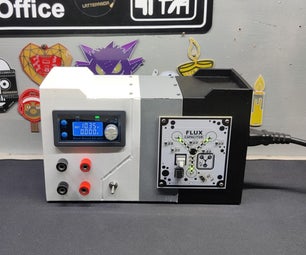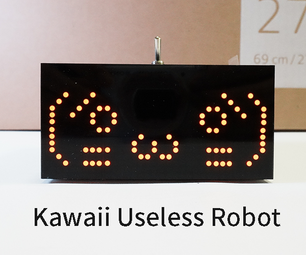Introduction: A (very) Simple LCD Backlight Fix
Fix any broken LCD backlight with an ordinary light bulb and a dead CRT monitor.
Broken LCD monitors basically come in three categories:
1) Cracked LCD panel, rendering the unit completely worthless
2) Backlight problem
3) Power supply problem
If it's a backlight or power supply problem, it can be fixed.
Usually, the problem stems from the high voltage inverter circuitry, either bad power transistors, capacitors, or thermal stress on the circuit board leading to broken solder joints.
But fixing these problems can often be a short term solution. The bulbs themselves have a limited lifespan, and the high voltage power supplies are prone to failure.
The panels themselves almost always outlive the backlights and high voltage power supplies.
The 17" Dell LCD monitor I found was no exception. When I first plugged it in, it would cycle power on and off continuously, with a notable burning smell. Further inspection revealed a fried power transistor. When i replaced it, the monitor stayed on, but the backlight would flicker on and off, then finally shut off after a few seconds..
The panel was good, but trying to fix the backlight with the proper parts wasn't really worth it.
But maybe I could still save it, or even make it better. After all, it's just a light. Lights should be user-replaceable things anyway.
I mean, a Lite-Brite was the cheapest toy, yet you could at least change the bulb.
So here's the result of my experiment, with help from an old CRT monitor:
Broken LCD monitors basically come in three categories:
1) Cracked LCD panel, rendering the unit completely worthless
2) Backlight problem
3) Power supply problem
If it's a backlight or power supply problem, it can be fixed.
Usually, the problem stems from the high voltage inverter circuitry, either bad power transistors, capacitors, or thermal stress on the circuit board leading to broken solder joints.
But fixing these problems can often be a short term solution. The bulbs themselves have a limited lifespan, and the high voltage power supplies are prone to failure.
The panels themselves almost always outlive the backlights and high voltage power supplies.
The 17" Dell LCD monitor I found was no exception. When I first plugged it in, it would cycle power on and off continuously, with a notable burning smell. Further inspection revealed a fried power transistor. When i replaced it, the monitor stayed on, but the backlight would flicker on and off, then finally shut off after a few seconds..
The panel was good, but trying to fix the backlight with the proper parts wasn't really worth it.
But maybe I could still save it, or even make it better. After all, it's just a light. Lights should be user-replaceable things anyway.
I mean, a Lite-Brite was the cheapest toy, yet you could at least change the bulb.
So here's the result of my experiment, with help from an old CRT monitor:
Step 1: Go to Trash, Locate a CRT Monitor
Take a CRT monitor, remove the guts and dispose, keeping just the shell and monitor stand.
Install a light bulb socket about 1/2 way back. I used switching socket from an old lamp.
(for the bulb, I used a 60w-equivalent "daylight"/6500k CFL bulb. It has a blueish glow to it. )
Install a light bulb socket about 1/2 way back. I used switching socket from an old lamp.
(for the bulb, I used a 60w-equivalent "daylight"/6500k CFL bulb. It has a blueish glow to it. )
Step 2: Cutout Back of LCD Monitor
For the LCD monitor, cutout the back and remove the metal shields/ PCB's behind the panel, allowing light to pass through it.
(This step varies a lot from brand to brand. Some brands will have ribbon connections on both the X and Y plane, while some just on the X plane. Fortunately, for my Dell monitor (which was actually a BenQ monitor), the ribbon connector was only on the X axis, so lifting it out of the way to allow light to pass through was easy, without requiring any extra wiring. )
For the panel light filters, there should be some diffusing paper/plastic behind the LCD, 3 sheets (one clear, one reflective, one translucent white), and then a large Plexiglass-like filter. I removed the Plexiglass and everything behind it, only keeping the 3 thin paper-like sheets behind the LCD. Shining a light behind the LCD resulted in an even white glow
(This step varies a lot from brand to brand. Some brands will have ribbon connections on both the X and Y plane, while some just on the X plane. Fortunately, for my Dell monitor (which was actually a BenQ monitor), the ribbon connector was only on the X axis, so lifting it out of the way to allow light to pass through was easy, without requiring any extra wiring. )
For the panel light filters, there should be some diffusing paper/plastic behind the LCD, 3 sheets (one clear, one reflective, one translucent white), and then a large Plexiglass-like filter. I removed the Plexiglass and everything behind it, only keeping the 3 thin paper-like sheets behind the LCD. Shining a light behind the LCD resulted in an even white glow
Step 3: Mounting the LCD
4) Relocate the boards from the LCD panel to the CRT shell, mount LCD panel, and connect everything up. For mounting everything I drilled holes and used zip ties.
Step 4: Results
See my project page for more pictures.
http://www.ccs.neu.edu/home/bchafy/monitor/crtlcd.html
Conclusion
This LCD was saved from the trash.
And now if the light ever goes out, it's easy to change. Also, as a bonus, the monitor vents glow, partly illuminating the desk and keyboard at night. Shouldn't all monitors be made this way?
:-)
Notes
LCD Monitor is a Dell E172FP.
When the monitor is off and the light is on, the display is more transparent than black, sort of a light/mid gray.
There is some minor hot-spotting, but not very serious. Given the type of cheap hack this is, it is more than acceptable.
Obviously, the monitor is more bulky than it used to be, but very light. Almost half the weight of LCD monitor as it was before.
Bathroom scale says it weighs 7lbs. (original LCD weight was 13.25lbs)
Gettting rid of the LCD's metal frame, stand, and heavy plexiglass light filter was the major contributor to the weight reduction.
The CRT's shell and base are just plastic (with some springs).
The LCD frame was smaller than the CRT's. I just cut out some cardboard to fill in the gaps to block out the light for now. I know, it looks ugly. Later, I'll make a better looking frame.
http://www.ccs.neu.edu/home/bchafy/monitor/crtlcd.html
Conclusion
This LCD was saved from the trash.
And now if the light ever goes out, it's easy to change. Also, as a bonus, the monitor vents glow, partly illuminating the desk and keyboard at night. Shouldn't all monitors be made this way?
:-)
Notes
LCD Monitor is a Dell E172FP.
When the monitor is off and the light is on, the display is more transparent than black, sort of a light/mid gray.
There is some minor hot-spotting, but not very serious. Given the type of cheap hack this is, it is more than acceptable.
Obviously, the monitor is more bulky than it used to be, but very light. Almost half the weight of LCD monitor as it was before.
Bathroom scale says it weighs 7lbs. (original LCD weight was 13.25lbs)
Gettting rid of the LCD's metal frame, stand, and heavy plexiglass light filter was the major contributor to the weight reduction.
The CRT's shell and base are just plastic (with some springs).
The LCD frame was smaller than the CRT's. I just cut out some cardboard to fill in the gaps to block out the light for now. I know, it looks ugly. Later, I'll make a better looking frame.









